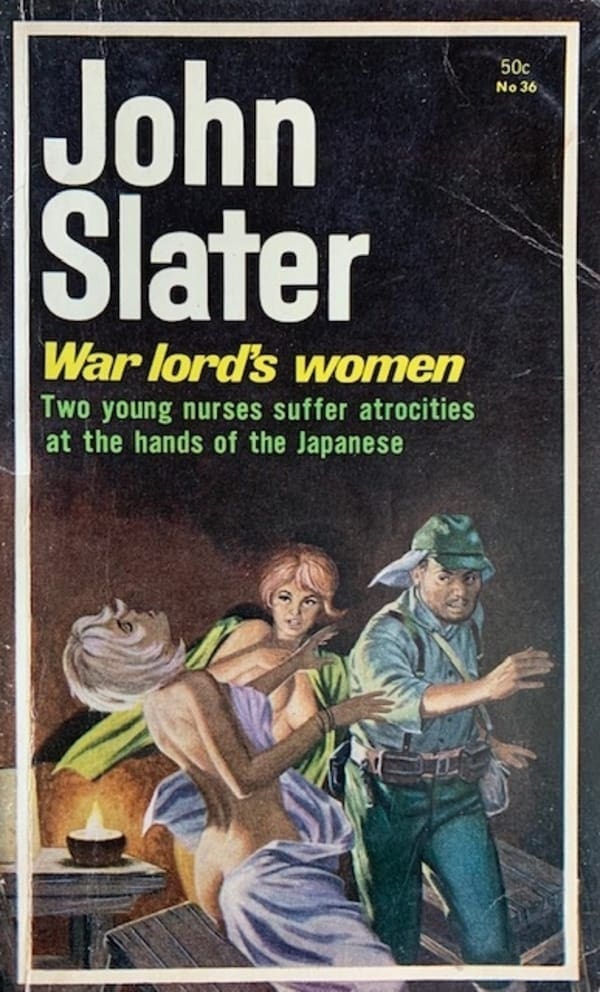TRASHY TUESDAY: JAPANESE HORROR CAMPS – THE JOHN SLATER POW NOVELS

World War II featured prominently in popular fiction well into the 1960s and 70s. In Australia there emerged in the 1960s a sub-genre of men’s adventure books about Australian soldiers and nurses being held as prisoners of war and the tortures they experienced under the Japanese. These books usually focussed on the cruelty of the Japanese guards and fed off the strong resentment towards the Japanese that still existed in the 1960s (and probably longer). These books did not dwell on battles, but rather on how the soldiers, and usually attractive young nurses, withstood the brutality of the guards. The books also had a particularly perverse fascination with the degradation of “white women” by the Japanese.
Horwitz Publishing produced several series along these lines, including the Jim Kent and Ray Slattery series of books, with titles like Chains Of Bamboo, Slave Women and Slaves of the Samurai. Probably the leading series in this sub-genre, however, were the John Slater books.
The John Slater series (Horwitz Publications) of exploitation novels ran from 1962 to 1973. Most of them were actually written by the prolific Ray Slattery and nearly all of them featured prisoners (usually women) being tortured by sadistic Nazi or Japanese guards during the war, or other forms of slavery and exploitation, such as Slave of the Apaches and Bikie Slave. The early books were initially about the Japanese POW camps and featured racially explicit taglines such as: “Inside a notorious prison camp where white women were made the unwilling playthings of their Japanese captors.”
Accompanying the descriptions were provocative covers that usually featured near-naked women, being tied up or beaten, or about to be subjected to some horrible act. The majority of the covers from 1964 onwards were done by famed illustrator Col Cameron, who did over a hundred covers for Australian paperbacks, mainly for Horwitz.
The first six books in the series all featured storylines about Japanese prison camps, but after this point they also moved onto Nazi themed books.
I have three of the first six books.
The first was The Horror Camp (1961). (The 1964 edition (above) had Horror Camp on the front cover, but The Horror Camp appeared on the spine and inside the book). The story was fairly typical of those which followed, with young American nurses trying to evade the Japanese on an island off Papua New Guinea, while a group of Australian POWs plot their escape from the Japanese so that can rescue the nurses. The local New Guineans also play a significant role in the story.
The cover by Col Cameron on the Second edition (above) is typical of the Slater books, but gives the wrong impression of the story. The nurses were never actually held captive by the Japanese, and there were only three, not the five on the cover. The girls were also never as scantily dressed as the cover suggests. The archetypical drawing of a mean looking Japanese soldier, with the ubiquitous samurai sword, completes the effect that the publishers were after. Despite some strong racist undertones towards the Japanese and the local New Guineans, it is not a terrible story and probably more action orientated than other books in the series.
I do not have the second, third and fourth books, Camp Hell, Camp Blood and Women’s Camp, but they seem to have similar storylines: “The Australians planned a daring bid to rescue the nurses from cruelty and horror” (Women’s Camp).

The fifth book in the series was Camp Of Terror (1963).

Camp Of Terror dealt with prisoners being held on the Indonesian Island of Java, with the central focus being the efforts of a Japanese officer to bend a Dutch girl, Stella, who was trapped on the island, to his will. It is a pretty standard story with some brutal scenes and mounting sexual tension between Stella and an Australian engineer. As with most of the books in the series, it ends abruptly and optimistically (all of the books I have seen usually end with most of the girls being luckily rescued at the very last moment).
The above cover on the second edition of the book (1966) is presumably by Col Cameron and again does not accurately portray the contents of the book. The tagline on the front cover also makes reference to Lois, who only has a small part in the book.
The sixth book was Sin Camp (1963).

Sin Camp again treaded very familiar territory with the treatment of six American nurses captured by the Japanese in Manila: “At the mercy of beasts! … They were dragged away to become the playthings of of bestial, sex-starved Jap officers.” (From the back cover)
The book has passages which are more suggestive, than in earlier books, of the sexual treatment of the nurses by the Japanese and contains some disturbing descriptions of how the local Filipino girls were treated. As with the other books, the ending is abrupt, as if the author had suddenly reached his word limit.
Again the cover is probably by Col Cameron and is very much in keeping with his later Nazi prison covers.
After Sin Camp, the series spread out to include stories about brutalities under the Nazis and in the German concentration camps, but Slater (Slattery) also returned to the theme of nurses being held captive by the Japanese in later books, such as Women Under The Samurai and War Lord’s Women (below).
The books cast a disturbing light on reading habits in the 1960s and there is probably a wealth of material there for researchers to reflect on, but there is no doubting the popularity of such books.

Thanks to Graeme Flanagan’s excellent Australian Vintage Paperback Guide for the publishing details. The cover for Women’s Camp was taken from Scott’s excellent site: http://suspenseandmystery.blogspot.com/2012/10/womens-camp-by-john-slater.html


‘The books cast a disturbing light on reading habits in the 1960s and there is probably a wealth of material there for researchers to reflect on, but there is no doubting the popularity of such books.’
I completely agree.